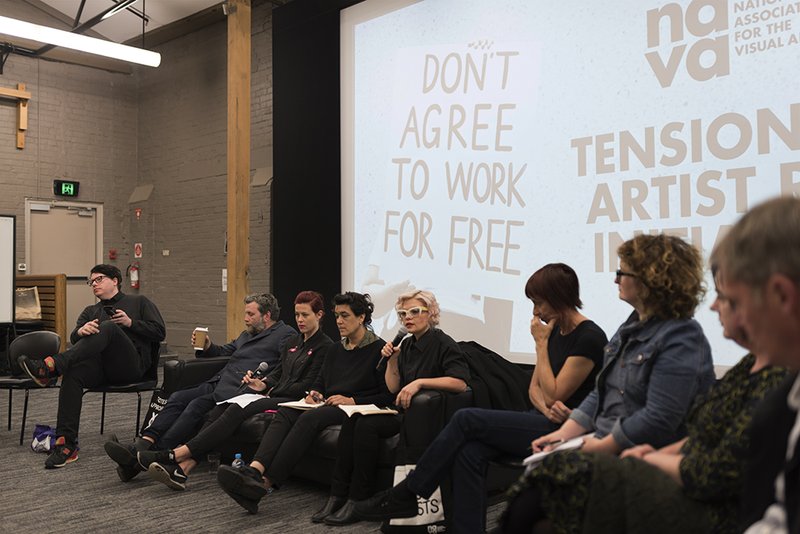HOBIENNALE
Conversations and take aways for NAVA from the recent HOBIENNALE festival.
Conversations and take aways for NAVA from the recent HOBIENNALE festival.

The HOBIENNALE (HB17) brought together a large group of artist-run initiatives (ARIs) from across Australia and New Zealand. Each ARI presented an exhibition in Hobart, Tasmania as part of the festival and participated in a free program of talks and conversations.
HB17 represented a significant shift in models, discussions and valuing of ARIs in Australia. The festival was designed to engage in real dialogues between ARIs about uncertainty, diminished funding opportunities, current strengths and future potentials. The talks, exhibitions and performances all set out to re-contextualise the challenges, issues and opportunities of ARIs as well as the artists and ideas that they support.
HOBIENNALE was created in response to the growing co-option of ARIs as ‘place making enterprises’. The festival firmly grounded the value of ARIs and their diverse visions, models, politics and aesthetics in a back-to-back program over 10 days. It was simultaneously a celebration of ARIs and a provocation to critically unpack the tensions of the artist run model.
NAVA was at HB17 to discuss the future of ARIs, the changing conditions, models and constant precarity of working in and managing an ARI, and how or where NAVA’s Fair Pay for Artists campaign fits in the context of ARIs. This national dialogue sought to unpack the tensions that are challenging and changing these spaces. Discussions ranged from artist fees and the impact of voluntary management, to the role of ARIs in the arts ecology, and the vision for equity in relationships with artists and other arts organisations.
One of the biggest issues raised by multiple speakers and participants of NAVA’s panel and subsequent conversations, was the issue of fees. While ARIs like Firstdraft can now afford to pay artists’ fees and some administrative staff, many are still reliant on volunteer labour and gallery hire costs to pay the rent. Tensions between affordable space, low paid staff, artists’ expectations, workloads, contributions and disrupting the voluntary models of management remain unresolved. While most ARIs unequivocally support the concept of artists’ fees and paid labour, payment of these fees are uniquely tied to the capacity and circumstances of each ARI. Artists, directors, arts professionals and organisations need to be clear on what is the purpose and goal of the ARI and what impact fees or salaries will have. Artists’ fees and paying staff in ARIs is a complicated issue and one that perhaps cannot be mandated without clear pathways to understanding the administrative impacts and high burn out rates. Indeed, it was noted by one speaker that artists are often the biggest philanthropists of the arts.
There is perhaps a role for NAVA to play here in supporting ARIs through advice, looking at working hours and expectations for voluntary management and collecting and monitoring the data of how artists contribute to the ARI sector.
NAVA also has a responsibility to play a greater advocacy role for ARIs. NAVA recognises there have been and continue to be significant changes to funding, space, accessibility and social and cultural expectations. All factors that contemporary ARIs are having to navigate. What this has created is a preoccupation with longevity and success that is tied intimately to growth. In order to be successful or sustain operations there is an expectation that ARIs need to grow, keep developing, getting bigger, more professionalised and sustainable. However, conversations at HB17 highlighted that there is desperate need to not equate growth with success, but instead look at progress. The progress of ideas, of artists, of clearly articulating the importance of continued and solid operations. This means redefining the ethos and expectations of funding agencies, or the broader arts sector and of the communities themselves. We need to be valuing what we have, developing our purpose and objectives, rather than measuring success and competitiveness through traditional paths of growth. This is where NAVA needs to start shifting the conversation.
With such a diversity of models, artists, directions and opportunities for ARIs, the greatest impact of HB17 was in drawing these together to create informal and formalised networks. For many, it was the first opportunity for artists and ARI directors (yes these are not mutually exclusive) to meet face to face, to see and discuss the thematics and politics that emerge from different states and territories, and to establish national communities for exchange.
The festival also carved out a unique space for placing value on collaboration. It identified how ARIs are already collaborating with each other, with artists, and developing new models of working. These are through both formalised models of mentorships, governance and management of space or informal networks, as artists move between ARIs across the country. The exhibitions presented at HB17 also looked at new ways that ARI directors are collaborating on works, projects and the establishment of the new national ARI network, All Conference.
HB17 attempted to really capture a moment, to engage both the physical and conceptual spaces of change. It demonstrated how ARIs are often contentious spaces, dynamic spaces that have the capacity for engaging with ideas of difference, producing different models, different relationships, different power balances and different audiences. They are the spaces that can exist without the formal mechanisms of institutions, allowing a broad platform for exciting experimentation and risk taking. Providing space that is not measured by traditional perspectives of success is vital to the development of artists’ practice and community. This value is why ARIs need to continue to exist and the role that organisations like NAVA should be playing in supporting the artists who are leading them.
Photo Lucy Parakhina.